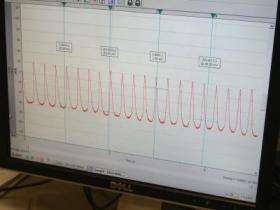New insights on heart's 'fight or flight' response to stress

Even for those without a heart condition, it's a peculiar feeling when your heart "races" in response to stress. That pacing change happens in part because of how the enzyme calcium/calmodulin-dependent protein kinase II (CaM kinase II) is called into action by the body's 'fight or flight' stress response, University of Iowa researchers have found.
The finding challenges traditional concepts of the heart's peacemaking function and adds support to the idea that finding ways to inhibit CaM kinase II could help control heart rate problems in people with arrhythmias and other heart conditions. The study results appear March 9 in the online Early Edition of the Proceedings of the National Academy of Sciences.
Previous understanding of the heart's pacemaking functions was focused on beta-adrenergic receptors, said Yuejin Wu, Ph.D., the study's lead investigator and a research scientist in internal medicine at the UI Roy J. and Lucille A. Carver College of Medicine.
"Beta-adrenergic receptor stimulation during stress ultimately increases activity of a particular ion channel, previously known as the 'pacemaker channel', and our current treatments for fast heart rates involve drugs that directly inhibit these beta-adrenergic receptors," Wu said. "In fact, we found that a significant part of the 'fight or flight' heart rate response depends on activation of the enzyme CaM kinase II during beta-adrenergic stimulation."
In a recent study from Germany, a mouse model that was missing the gene for the pacemaker ion channel surprisingly responded normally to the drug isoproterenol. Similar to adrenaline, isoproterenol can increase heart rate. This response meant that the ion channel, by itself, does not explain the physiological "fight or flight" heart rate response.
Based on this observation, Wu and other colleagues in the lab of the paper's senior author, Mark Anderson, M.D., Ph.D., head of the UI Division of Cardiovascular Medicine, developed mice in which the CaM kinase II function was inhibited in heart cells. When these mice were exposed to the adrenaline-like agent isoproterenol, the stimulant's effect did not occur. As a result, the mice without CaM kinase II function had much slower heart rates than mice that had normal CaM kinase II function. The finding underscored that CaM kinase II activation can increase heart rates.
"In a person whose heart beats at a normal rate, you would not want to inhibit CaM kinase II function," Wu said. "But our findings suggest that in people with rapid heart rates it could be beneficial to inhibit the enzyme's function. When the heart beats too fast, it does not pump well, and if a fast heart rate, persists it can damage the heart's muscle."
This research focused specifically on specialized heart cells called sinoatrial nodal cells, which help maintain the heart's normal rhythm. Compared to other heart cells, which affect contraction, there are very few sinoatrial cells -- perhaps only a few hundred. This scarcity means each cell is critical for normal heart function. The same scarcity also has made it challenging to find enough cells for research purposes.
Based on research done in France, Wu and colleagues were able to develop a method to extract single sinoatrial nodal cells from mouse models for examination. Unlike ventricular cells, sinoatrial nodal cells can beat on their own without electrical stimulation, allowing scientist to see their activity when extracted.
"By examining single cells, we were able to see very basic mechanisms", Wu said. "The sinoatrial cells taken from mice with inhibited CaM kinase II were not able to facilitate calcium function, and thus, each cell's ability to beat slowed down. Since people with arrhythmias have a heart beat that is too fast, the opposite problem may be true -- there is too much CaM kinase II function, resulting in calcium overload."
The team will continue to study pathways by which CaM kinase II functions and affects the heart.
Source: University of Iowa














